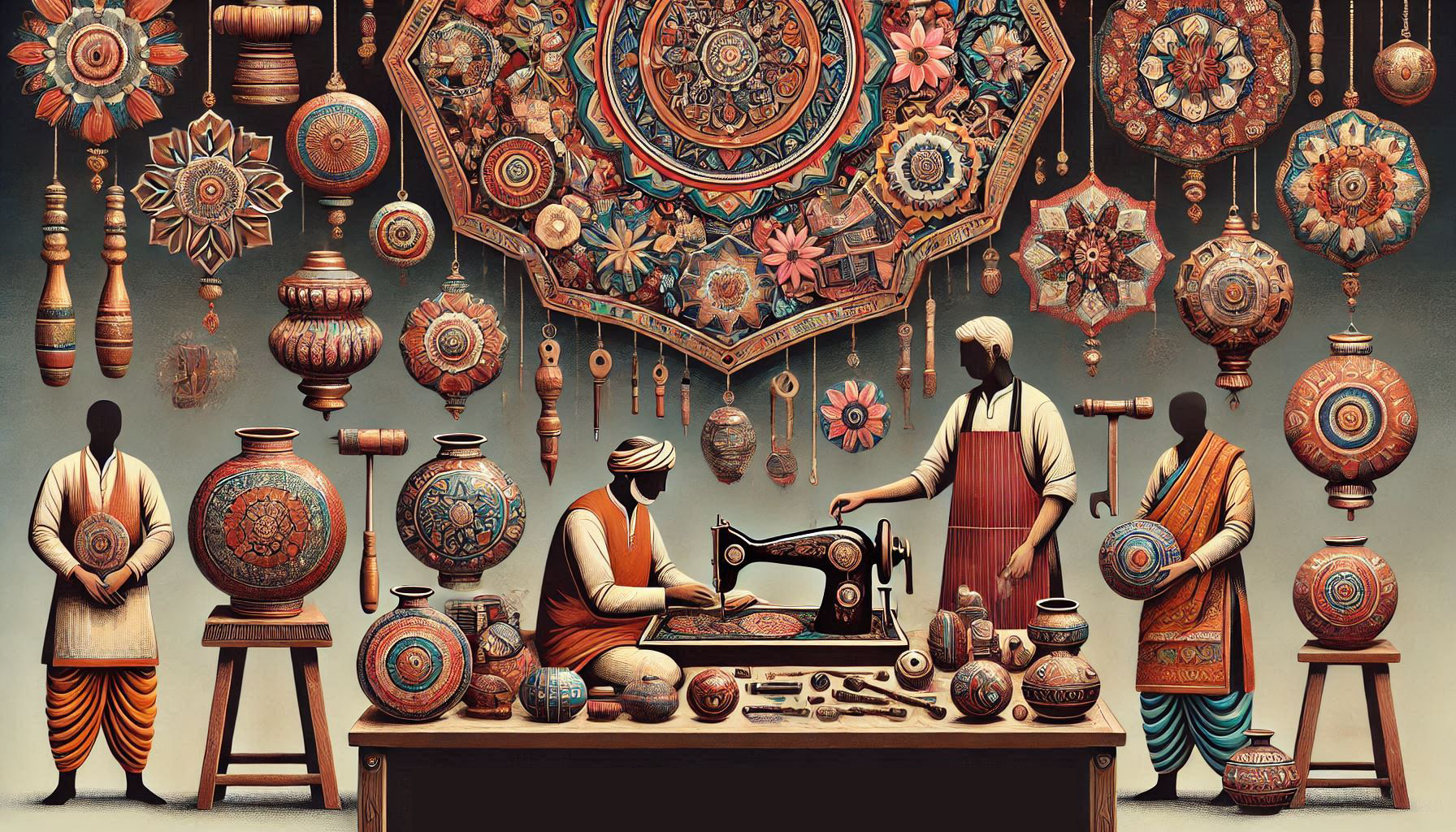Table of Contents
Introduction About Indian art and crafts
Indian art and crafts are not merely decorative items; they are a rich tapestry woven with history, culture, and tradition. Each state in India has its unique styles, techniques, and materials that give rise to distinct crafts, reflecting local heritage and artistic expression. As we delve into the fascinating world of Indian art and crafts, we will explore what makes these handicrafts unique, the artisans behind them, and the cultural significance that imbues every piece with a story and purpose. This guide will take you through the myriad dimensions of Indian art and crafts, celebrating the beauty and creativity that flourish in this incredible country.
1. Which Handicraft is Famous in India?

India is home to numerous Indian art and crafts, each renowned for its unique characteristics and cultural significance. From the exquisite craftsmanship of Pashmina shawls in Jammu and Kashmir to the intricate beadwork of tribal crafts in Gujarat, the range is vast. Among the most famous crafts are:
- Pashmina Shawls: These luxurious shawls are known for their incredible softness and warmth, often intricately woven with beautiful designs that reflect the artistry of Kashmiri artisans.
- Madhubani Paintings: Originating from Bihar, this painting style features vibrant colors and detailed patterns depicting mythological themes and nature, making it a popular art form.
- Blue Pottery: Renowned for its vibrant blue shades, this pottery craft is primarily produced in Jaipur, Rajasthan, and is recognized for its artistic beauty and utility.
- Phulkari Embroidery: Known for bright, floral patterns, this traditional embroidery from Punjab adds color and vibrancy to garments and home textiles.
- Warli Art: A tribal art form from Maharashtra, Warli paintings use simple geometric shapes to depict everyday life, highlighting the deep connection between nature and tribal culture.
These famous Indian art and crafts exemplify the unique craftsmanship and cultural narratives that are essential to its artistic identity.
2. How Many Arts and Crafts are There in India?

The arts and crafts of India are as diverse as its cultures, with thousands of unique styles spread across its numerous states. Each region boasts particular crafts that evolve through time and cultural exchanges. While it’s challenging to quantify the exact number of crafts, various categories can be identified:
- Textiles: Each state produces unique textiles, from the silk of Varanasi to the handwoven dhurries of Rajasthan.
- Paintings and Art Forms: Styles range from Tanjore paintings in Tamil Nadu to the vibrant Madhubani art in Bihar, and Warli art in Maharashtra.
- Pottery: Different regions are famous for their pottery styles, such as Khurja ceramics and terracotta items from Bengal.
- Wood and Metal Crafts: Skills in woodworking and metalworking vary, with notable crafts like wooden toys from Rajasthan and Bidriware from Karnataka.
- Handicrafts: A category that includes woven crafts, jewelry, and decorative artifacts, hallmarked by local materials and techniques.
This indicates a vast and vibrant craft world within India, showcasing talents and creativity found across the country.
3. What are the Traditional Arts and Crafts?

Traditional Indian art and crafts are artistic expressions deeply rooted in the cultural heritage of a community. They encompass a wide range of materials and techniques reflective of local history, tradition, and social values. Some key examples include:
- Handloom Weaving: This involves traditional weaving techniques that produce fabrics like the iconic Banarasi silk and Kanjeevaram sarees, representing regional pride and craftsmanship.
- Pottery: Traditional pottery reflects local customs and is often used in festivals and rituals. The beautiful designs often have symbolic meanings related to social or religious beliefs.
- Embroidery: Styles such as Chikankari from Lucknow and Kutch embroidery from Gujarat add texture and charm to garments and home furnishings, each with patterns that tell their own stories.
- Metalwork: Crafting metal items using traditional methods, which often include Kundan jewelry and intricately etched brassware, showcases the skills that have been honed for generations.
These traditional Indian art and crafts represent not only the regional aesthetics but also the values, histories, and narratives of the communities that create them.
4. What is the History of Indian Arts and Crafts?

The history of Indian art and crafts dates back thousands of years, making it one of the oldest and most rich artistic traditions in the world. The origins of many crafts can be traced to the ancient Indus Valley Civilization, where evidence suggests the use of pottery, weaving, and metallurgy. Over the centuries, Indian crafts have evolved, influenced by various dynasties, cultural migrations, and socio-political changes.
- Ancient Civilizations: The Indus Valley Civilization (around 3300-1300 BCE) showed sophistication in craftsmanship, with evidence of pottery, bead-making, textiles, and terracotta figurines found in archaeological sites. These early forms of crafts laid the foundation for future generations.
- Mughal Influence: The arrival of the Mughals in the 16th century significantly impacted Indian arts and crafts. They introduced intricate designs, rich motifs, and exquisite techniques in textiles, metalwork, and architecture. Crafts like Tanjore painting and intricate wood inlay work flourished under Mughal patronage.
- Colonial Era: During British colonial rule, traditional crafts often faced challenges as mass production and industrialization began to rise. Despite this, several crafts adapted by incorporating new materials and methods, which helped preserve their essence.
- Post-Independence Revival: After India’s independence in 1947, there was a renewed focus on promoting traditional crafts, leading to various programs aimed at supporting local artisans. Organizations like the Handicrafts and Handloom Export Corporation (HHEC) were established to uplift artisans and endorse their crafts on international platforms.
5. Engaging with Craftsmanship in India

Engaging with the craftsmanship of India is not limited to purchasing items; it also involves understanding the stories and lives of the artisans behind these unique creations. Each artisan carries forward techniques developed over generations, ensuring that the heritage of their craft is preserved.
- Personal Connections: When you purchase handmade goods, you are often buying not just a product, but also supporting a craftsperson’s livelihood. Each piece reflects countless hours of dedication, skill, and passion, making it a uniquely personal gift or decor item.
- Artisan Communities: Many craftspeople participate in cooperative societies to enhance production and marketing strategies, allowing them to uphold their age-old valor while adapting to modern markets. Engaging in community-based handicrafts promotes social empowerment and economic stability.
- Workshops and Cultural Programs: Participating in local workshops or cultural programs can provide insights into traditional crafting techniques. These experiences also allow individuals to connect with artisans and learn the skills necessary to create their own pieces.
6. Popular Crafts by Region

India’s crafting traditions vary widely by region, with each state offering its unique styles and specialties.
- Jammu and Kashmir: Known for Pashmina shawls and intricate woodwork, the artisans of this region create luxurious products that reflect their rich heritage.
- Punjab: Famed for Phulkari embroidery, which features bright floral patterns on fabrics, reflecting the vibrancy of Punjabi culture.
- Gujarat: Home to Bandhani tie-dye, which uses color and design to create unique textiles that are often worn during celebrations.
- Rajasthan: Renowned for blue pottery, characterized by vibrant designs and colors; artisans craft functional items with artistic flair.
- West Bengal: Celebrated for Kantha stitching, which repurposes old saris into beautiful quilts and serves as a sustainable craft approach.
7. The Relevance of Indian Crafts Today

In today’s world, the importance of Indian art and crafts extends beyond mere decoration. They have found their place in modern lifestyles as sustainable choices and contribute to responsible consumer behavior.
- Sustainability: Eco-friendly practices are at the forefront of artisanal crafting. Many artisans utilize sustainable materials, reducing their carbon footprint and emphasizing the value of natural resources.
- Cultural Exchange: Indian crafts have gained international recognition, leading to cultural exchanges that promote craftsmanship worldwide. Art fairs and online platforms allow artisans to reach broader audiences and share their artistry outside India.
- Revival of Interest: There is a growing trend of supporting local craftsmanship among consumers who value authenticity and uniqueness. This has led to a revival of interest in traditional crafts and increased demand for custom, handcrafted goods.
Conclusion
The heritage Indian art and crafts are a treasure trove of artistic expression, cultural identity, and sustainability. Exploring the world of traditional crafts offers insights into the rich narratives woven throughout the fabric of Indian society. From the intricate details of textiles to the rustic charm of pottery, each craft tells a story of tradition and creativity.
As we appreciate these crafts, let us support the artisans who dedicate their lives to preserving these traditions. By choosing handmade items, we not only acquire unique and meaningful gifts but also contribute to the sustainability of local economies and ensure that these invaluable art forms continue to flourish.
Celebrating the Indian art and crafts scene means embracing the creativity and heritage embedded in every piece. Whether you are filling your home with stunning handicrafts or presenting thoughtful gifts to loved ones, you are participating in a tradition that honors skilled craftsmanship and cultural narratives.
This New Year and beyond, make it a point to explore and invest in Indian art and crafts that resonate with you. Dive into the vibrant artisanal world of India, where every purchase is a celebration of art, love, and community.
FAQs
What types of crafts are popular in India?
India boasts a wide range of popular crafts, including textiles (like Pashmina and silk sarees), pottery (like terracotta and blue pottery), woodwork (such as carved furniture), and various forms of embroidery (like Phulkari and Chikankari).
How can I ensure I am buying authentic Indian handicrafts?
To ensure authenticity, purchase from established artisanal markets, cooperatives, and reputable online platforms that highlight their artisans and sourcing practices. Look for certifications or labels that indicate genuine handmade products.
How do traditional crafts contribute to the local economy?
Traditional crafts provide livelihoods for artisans and their families, often sustaining entire communities. Supporting these crafts encourages local economies, preserving not only the crafts but also the cultural practices associated with them.
Why should I choose handmade crafts over mass-produced items?
Handmade crafts are often unique, reflecting the artisan’s skill and cultural heritage. They carry personal stories and craftsmanship that mass-produced items lack. Choosing handmade supports sustainable practices and local economies.
Can I learn to make traditional crafts?
Yes! Many artisans offer classes and workshops where you can learn traditional crafts such as pottery, weaving, or embroidery. Engaging in these activities can enhance your appreciation for the craft and connect you with your cultural heritage.
Explore our curated collection of Heritage Indian art and crafts today! Discover unique and beautiful pieces that reflect the artistry and skill of local artisans. Whether you’re looking for gifts or decor items, every piece carries a story that enhances your living space and supports the traditional craftsmanship of India. Join us in celebrating art, culture, and community—shop now and inspire a love for handmade artistry in your home!
🌟 Join Our Crafting Community! 🌟
If you’re passionate about Indian art and crafts, artisanal craftsmanship, and the beauty of traditional techniques, don’t miss out! Subscribe to our YouTube channel for inspiring craft tutorials, expert insights, and behind-the-scenes looks at the incredible world of Indian artisans. Be part of our journey to celebrate and preserve the rich heritage of Indian crafts. Hit that subscribe button and turn on notifications so you never miss an update!
🎨 Let’s craft the future together with sustainable and vibrant creations! ✂️













